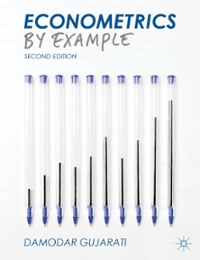Question
1) One drawback of monopoly is the practice of rent-seeking behaviour, an example of which occurs when: a. a firm buys another firm that also
1) One drawback of monopoly is the practice of rent-seeking behaviour, an example of which occurs when:
a.
a firm buys another firm that also enjoys monopoly rents.
b.
a firm devotes resources to deter entry.
c.
a firm tries to increase the rents it charges on property it owns.
d.
a government tries to find out the size of a firm's monopoly rents
e.
a government tries to expropriate a firm's monopoly rents.
2)In what sense is a monopolist's price viewed by economists as too high?
a.
The profit-maximising price is above the market clearing price.
b.
The profit-maximising price is above marginal cost.
c.
The profit-maximising price does not bring forth an output such that the market clears.
d.
The profit-maximising price exceeds what consumers think as a fair price.
e.
The profit-maximising price is above the equilibrium price.
3)When economists state that competition drives profits to zero, they mean that:
a.
existing firms can increase long-run profits by increasing production, but it is not profitable for new firms to enter the market.
b.
existing firms can increase long-run profits by increasing production, and it may be profitable for new firms to enter the market.
c.
the marginal existing firm can increase long-run profits by increasing production, though other existing firms cannot, nor is it profitable for new firms to enter the market.
d.
no existing firm can increase long-run profits by increasing production, and it is not profitable for new firms to enter the market.
e.
no existing firm can increase long-run profits by increasing production, though it may be profitable for new firms to enter the market.
4) A tax has been levied on a product. The more price inelastic the demand for that product is:
a.
the greater is the revenue that is raised by the tax.
b.
the smaller is the proportion of the tax borne by consumers.
c.
the less likely it is that the tax will be reflected in a change in price rather than a change in quantity.
d.
the more likely it is that the tax is borne equally by consumers and sellers.
e.
the lower is the revenue that is raised by the tax.
5) An increase in the exchange rate between one currency and other currencies under a fixed exchange rate system is called:
a.
devaluation.
b.
speculation.
c.
appreciation.
d.
depreciation.
e.
revaluation.
6)Three methods the government can use to cope with the external cost from pollution are
a.
pollution taxes, regulations, and subsidies.
b.
marketable permits, pollution subsidies, and pollution taxes.
c.
pollution charges, marketable permits, and pollution limits.
d.
vouchers, pollution subsidies, and pollution taxes.
e.
pollution taxes, subsidies, and outright bans.
7) The free-rider problem associated with a ____ good refers to the ____ cost of exclusion. In such cases, the private market ____ the good.
a.
public; low; undersupplies
b.
public; infinite; undersupplies
c.
private; low; undersupplies
d.
public; high; undersupplies
e.
private; high; oversupplies
8) Why are private firms unable to produce public goods?
a.
The tragedy of the commons means that private firms produce an inefficient amount of public goods.
b.
They can produce these goods, but they would not earn any revenue because of the free-rider problem.
c.
The marginal cost of production is too high for private production to be possible.
d.
Because the government outlaws private firms from producing them.
e.
None of the above answers is correct.
9) If the exchange rate between the Australian dollar and Chinese yuan is originally 6= $1, and the Chinese yuan depreciates to 7 = 1$, this change will mean that there will be:
a.
an increase in Chinese goods exported to Australia and an increase in Australian goods exported to China.
b.
the same number of Chinese exports to Australia and a decrease in Australian goods exported to China.
c.
an increase in Chinese goods exported to Australia and less Australian goods exported to China.
d.
a decrease in Chinese goods exported to Australia and an increase in Australian goods exported to China.
e.
an increase in Chinese goods exported to Australia and no change in Australian goods exported to China.
Step by Step Solution
There are 3 Steps involved in it
Step: 1

Get Instant Access to Expert-Tailored Solutions
See step-by-step solutions with expert insights and AI powered tools for academic success
Step: 2

Step: 3

Ace Your Homework with AI
Get the answers you need in no time with our AI-driven, step-by-step assistance
Get Started


